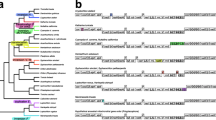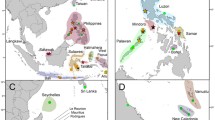Abstract
Dating the divergence between the two known living species of coelacanths has remained a difficult issue because of the very ancient origin of this lineage of fish, which is more closely related to tetrapods than to other fishes. We sequenced the complete mitochondrial genome of a recently captured individual of the Indonesian coelacanth in order to solve this issue. Using an approach based on loglinear models, we studied the molecular divergence between the two species of coelacanths and three other pairs of species, one that has diverged recently (Pan) and two that have diverged more distantly in the past. The loglinear models showed that the divergence between the two species of coelacanths is not significantly different from the two species of Pan. A detailed gene by gene analysis of the patterns of nucleotide and amino acid substitutions between these two pairs of species further supports the similarity of these divergences. On the other hand, a molecular dating analysis suggested a much older origin of the two coelacanth species (between 20 and 30 million years ago). We discuss the potential reasons for this discrepancy. The analysis of new individuals of the Indonesian coelacanth will certainly help to solve this issue.





Similar content being viewed by others
References
Agresti A (2002) Categorical data analysis, 2nd edn. Wiley, New York
Akaike H (1973) Information theory and an extension of the maximum likelihood principle. In: Petrov BN, Csaki F (eds) Proceedings of the second international symposium on information theory, Akadémia Kiado, Budapest, pp 267–281
Balloux F (2009) The worm in the fruit of the mitochondrial DNA trees. Heredity doi:10.1038/hdy.2009.122
Balloux F, Handley LJ, Jombart T, Liu H, Manica A (2009) Climate shaped the worldwide distribution of human mitochondrial DNA sequence variation. Proc R Soc Lond B 276:3447–3455
Bazin E, Glémin S, Galtier N (2006) Population size does not influence mitochondrial genetic diversity in animals. Science 312:570–572
Benton MJ, Donoghue PCJ (2007) Paleontological evidence to date the tree of life. Mol Biol Evol 24(1):26–53. Erratum 24:889–891
Charif D, Lobry J (2007) SeqinR 1.0-2: A contributed package to the R project for statistical computing devoted to biological sequences retrieval and analysis. In: Bastolla U, Porto HRM, Vendruscolo M (eds) Structural approaches to sequence evolution: molecules, networks, populations. Springer, New York, pp 207–232
Erdmann MV (1999) An account of the first living coelacanth known to scientists from Indonesian waters. Environ Biol Fish 54:439–443
Erdmann MV, Caldwell RL, Jewett SL, Tjakrawidjaja A (1999) The second recorded living coelacanth from north Sulawesi. Environ Biol Fish 54(4):445–451
Gordon AL (1998) Coelacanth populations may go with the flow. Nature 395:634
Heibl C (2010) LAGOPUS: R-package for Bayesian relaxed-clock molecular dating. http://www.christophheibl.de
Holder MT, Erdmann MV, Wilcox TP, Caldwell RL, Hillis DM (1999) Two living species of coelacanths? Proc Natl Acad Sci USA 96(22):12616–12620
Inoue JG, Miya M, Venkatesh B, Nishida M (2005) The mitochondrial genome of Indonesian coelacanth Latimeria menadoensis (Sarcopterygii: Coelacanthiformes) and divergence time estimation between the two coelacanths. Gene 349:227–235
Kimura M (1980) A simple method for estimating evolutionary rates of base substitutions through comparative studies of nucleotide sequences. J Mol Evol 16:111–120
Kimura M (1983) The neutral theory of molecular evolution. Cambridge University Press, Cambridge
Lanfear R, Thomas JA, Welch JJ, Brey T, Bromham L (2007) Metabolic rate does not calibrate the molecular clock. Proc Natl Acad Sci USA 104(39):15388–15393
Miller HC, Moore JA, Allendorf FW, Daugherty CH (2009) The evolutionary rate of tuatara revisited. Trends Genet 25(1):13–15
Nabholz B, Glémin S, Galtier N (2009) The erratic mitochondrial clock: variations of mutation rate, not population size, affect mtDNA diversity across birds and mammals. BMC Evol Biol 9:54
Nei M, Kumar S (2000) Molecular evolution and phylogenetics. Oxford University Press, Oxford
Nelson JS (2006) Fishes of the world, 4th edn. Wiley, Hoboken
Paradis E, Claude J, Strimmer K (2004) APE: analyses of phylogenetics and evolution in R language. Bioinformatics 20(2):289–290
Parham JF, Irmis RB (2008) Caveats on the use of fossil calibrations for molecular dating: a comment on Near et al. Am Nat 171(1):132–136
Pereira SL, Baker AJ (2006) A mitogenomic timescale for birds detects variable phylogenetic rates of molecular evolution and refutes the standard molecular clock. Mol Biol Evol 23:1731–1740
Perry GH, Tito RY, Verrelli BC (2007) The evolutionary history of human and chimpanzee Y-chromosome gene loss. Mol Biol Evol 24(3):853–859
Piganeau G, Eyre-Walker A (2009) Evidence for variation in the effective population size of animal mitochondrial DNA. Plos One 4(2):e4396
Pouyaud L, Wirjoatmodjo S, Rachmatika I, Tjakrawidjaja A, Hadiaty R, Hadie W (1999) A new species of coelacanth. C R Acad Sci III 322:261–267
Pulquério MJF, Nichols RA (2007) Dates from the molecular clock: how wrong can we be? Trends Ecol Evol 22(4):180–184
R Development Core Team (2009) R: a language and environment for Statistical Computing. R Foundation for Statistical Computing, Vienna, Austria. http://www.R-project.org
Raaum RL, Sterner KN, Noviello CM, Stewart CB, Disotell TR (2005) Catarrhine primate divergence dates estimated from complete mitochondrial genomes: concordance with fossil and nuclear DNA evidence. J Hum Evol 48(3):237–257
Santini F, Harmon LJ, Carnevale G, Alfaro ME (2009) Did genome duplication drive the origin of teleosts? A comparative study of diversification in ray-finned fishes. BMC Evol Biol 9:194
Sasaki T, Sato T, Miura S, Bwathondi POJ, Ngatunga BP, Okada N (2007) Mitogenomic analysis for coelacanths (Latimeria chalumnae) caught in Tanzania. Gene 389(1):73–79
Schartl M, Hornung U, Hissmann K, Schauer J, Fricke H (2005) Relatedness among east African coelacanths. Nature 435:901
Smith JLB (1939) A living fish of Mesozoic type. Nature 143:455–456
Springer VG (1999) Are the Indonesian and western Indian Ocean coelacanths conspecific: a prediction. Environ Biol Fish 54(4):453–456
Subramanian S, Hay JM, Mohandesan E, Millar CD, Lambert DM (2009) Molecular and morphological evolution in tuatara are decoupled. Trends Genet 25(1):16–18
Thomas JA, Welch JJ, Woolfit M, Bromham L (2006) There is no universal molecular clock for invertebrates, but rate variation does not scale with body size. Proc Natl Acad Sci USA 103(19):7366–7371
Thompson JD, Gibson TJ, Plewniak F, Jeanmougin F, Higgins DG (1997) The CLUSTAL_X windows interface: flexible strategies for multiple sequence alignment aided by quality analysis tools. Nucleic Acids Res 25(24):4876–4882
Thorne JL, Kishino H (2002) Divergence time and evolutionary rate estimation with multilocus data. Syst Biol 51(5):689–702
Thorne JL, Kishino H, Painter IS (1998) Estimating the rate of evolution of the rate of molecular evolution. Mol Biol Evol 15(12):1647–1657
Won YJ, Hey J (2005) Divergence population genetics of chimpanzees. Mol Biol Evol 22(2):297–307
Yang Z (2007) PAML 4: phylogenetic analysis by maximum likelihood. Mol Biol Evol 24(8):1586–1591
Yee TW (2009) VGAM: vector generalized linear and additive models. R package version 0.7-8. http://www.stat.auckland.ac.nz/~yee/VGAM
Yokoyama S, Tada T (2000) Adaptive evolution of the African and Indonesian coelacanths to deep-sea environments. Gene 261(1):35–42
Zardoya R, Meyer A (1997) The complete DNA sequence of the mitochondrial genome of a “living fossil,” the coelacanth (Latimeria chalumnae). Genetics 146:995–1010
Acknowledgments
We are grateful to Thibaut Jombart and an anonymous reviewer for their constructive comments on a previous version of this paper. This research was financially supported by an Action Thématique Incitative of the Institut de Recherche pour le Développement.
Author information
Authors and Affiliations
Corresponding author
Additional information
Communicated by M. I. Taylor.
Rights and permissions
About this article
Cite this article
Sudarto, Lalu, X.C., Kosen, J.D. et al. Mitochondrial genomic divergence in coelacanths (Latimeria): slow rate of evolution or recent speciation?. Mar Biol 157, 2253–2262 (2010). https://doi.org/10.1007/s00227-010-1492-7
Received:
Accepted:
Published:
Issue Date:
DOI: https://doi.org/10.1007/s00227-010-1492-7




